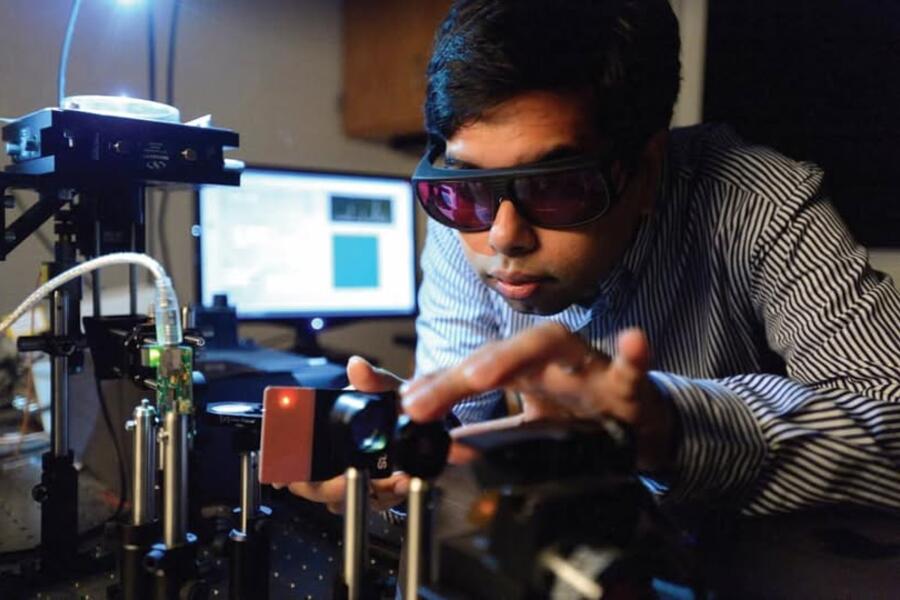- Name
- Doug Donovan
- dougdonovan@jhu.edu
- Office phone
- 443-997-9909
- Cell phone
- 443-462-2947
A team of Johns Hopkins engineers has developed a new, more powerful method to observe molecular vibrations, an advance that could have far-reaching implications for early disease detection.
The team, led by Ishan Barman, a professor in the Department of Mechanical Engineering, was the first to show how light can be used to form special hybrid states with molecules—allowing even the tiniest vibrations to be detected with greater clarity and precision.
The team's findings were recently published in Science Advances.
Key Takeaways
- Molecular vibrations—the tiny, unique movements of atoms within a molecule—offer chemical “fingerprints” that can reveal the presence of diseases ranging from infections and metabolic disorders to cancer.
- Current detection methods suffer from limitations: Signals are often faint, easily drowned out by background noise, and hard to isolate in complex biological environments like blood or tissue.
- The new technique creates special hybrid states with molecules, allowing even the tiniest vibrations to be detected with greater clarity and precision.
In healthcare, this new method for detecting molecules could translate into earlier, more accurate detection of disease biomarkers found in blood, saliva, or urine. But it could have other implications for broader medical use: In pharmaceutical manufacturing, it could enable real-time monitoring of complex chemical reactions to ensure product consistency and safety; and in environmental science, it could allow trace-level detection of pollutants or hazardous compounds with unprecedented reliability.
Molecular vibrations—the tiny, unique movements of atoms within a molecule—offer chemical "fingerprints" that can reveal the presence of diseases ranging from infections and metabolic disorders to cancer.

Image caption: Ishan Barman
Image credit: Johns Hopkins
Scientists commonly use techniques like infrared and Raman spectroscopy to detect these vibrations, but these methods suffer from fundamental limitations: The signals they rely on are often faint, easily drowned out by background noise, and hard to isolate in complex biological environments like blood or tissue.
"We were trying to overcome a long-standing challenge in molecular sensing: How do you make optical detection of molecules more sensitive, more robust, and more adaptable to real-world conditions?" said Barman, who holds joint appointments in the Sidney Kimmel Comprehensive Cancer Center and in the Department of Radiology and Radiological Science at the Johns Hopkins School of Medicine. "Rather than trying to incrementally improve conventional methods, we asked a more radical question: What if we could re-engineer the very way light interacts with matter to create a fundamentally new kind of sensing?"
The team used highly reflective gold mirrors to form an optical cavity, which traps the light and "bounces" it back and forth, greatly enhancing its interaction with the enclosed molecules. The confined light field and molecular vibrations become so intertwined that they form entirely new quantum states called "vibro-polaritons."
The team was able to achieve this feat under ambient, real-world conditions, without the need for high-vacuum, cryogenic, or other extreme environments, which are typically required to preserve fragile quantum states. Lead author Peng Zheng, an associate research scientist in mechanical engineering at Johns Hopkins, said this study details how to transform "quantum vibro-polaritonic sensing" from a conceptual idea into a functioning platform—and that this could lead to a new class of quantum-enabled optical sensors.
"Rather than passively detecting molecules, we can now engineer the quantum environment around them to selectively enhance their optical fingerprints by utilizing the quantum vibro-polaritonic states," said Zheng.
By using quantum principles in a new way, without the need for traditional infrastructure, this study marks a major milestone in advancing the nascent field of ambient-condition quantum technologies. Ultimately, Barman envisions compact, microchip-scale devices that could bring these quantum technologies to portable, point-of-care tools and AI-powered diagnostic methods.
"The future of quantum sensing isn't stuck in the lab—it's poised to make a real-world impact across medicine, biomanufacturing, and beyond," Barman said.
This study was funded by the National Institute of General Medical Sciences. Steve Semancik, physicist at the National Institute of Standards and Technology (NIST), was a co-author on the study.
Posted in Science+Technology
Tagged mechanical engineering








